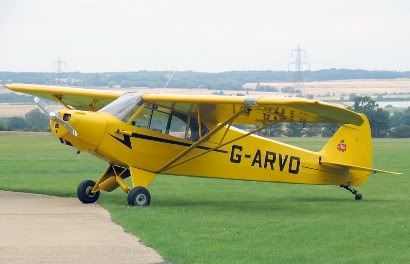As I am now working permanently during the week in Peterborough, I decided to check out the Northamptonshire School of Flying at Peterborough Sibson to see if I could do a taildragger rating there during the week after work. They seem to be open late in the summer on Wednesday, Thursday and Friday, so after a chat with the CFI, I booked my first lesson in the Piper Cub for Thursday evening just after work. In fact, it was on the way home as I normally catch up with paperwork and work from home on Friday (yes, the wife wondered why I was so late back – ‘the traffic couldn’t have been that bad!’).
When I booked, they said ‘oh, you will be with James Bryan – he is quite a character’. I did wonder what that meant until I met him. I am not short at 6’ 2” and 210 lbs, but he is huge! I would guess 6’ 4” and 240 lbs with hands like spades – will the Cub ever take off with the two of us?
He checked my experience and briefed me on what we would do and how to handle the Cub. He wouldn’t give me many of ‘the numbers’ I am used to, other than the approach speed. ‘We don’t do the numbers on this, you’ll know when it wants to fly’. OK – may the force be with me!
The plan was to fly over to nearby Deenethorpe airfield with its 1200m tarmac runway and do circuits but with a twist. We would land as short as possible, then my job was to hold the back wheel off and hold it straight down the runway with the rudder pedals, while he controlled the throttle. When close to the end of the runway, I would take control and do a normal take-off. Then we repeat the process etc. The ideal being to nail a three-point landing and get used to ground handling and ‘dancing on the pedals’ to hold a taildragger straight – which seems to be the hardest part (the dreaded ground-loop in a crosswind at low speed on the ground).
The aircraft itself is a real oldie. Rag and tube and external control wires. High wing and tandem seating. The controls and switches look like they have been positioned with all the care and attention that you might lavish to painting an outside window in a hurricane. There is no real method to actually getting in for big guys like us, so after trying a couple of different ways, I finally discover one that works!

Well, we took off using a technique quite different from the Arrow – full power, stick fully forward until the tail comes up, then ease back gently all the time keeping the tail up until she is flying (while at the same time, dabbing the rudder with either foot to keep it straight down the runway), then hold in ground effect to get the wing really flying (not on the back side of the drag curve) then ease her up over the trees (always a bonus) at the end of the runway.
We levelled out well below 1000’ then did some general handling. It certainly likes the rudder in the turns. Then James urged me to take her down low-level where I flew along woods and fields – fantastic.
We arrived at Deenethorpe and James demonstrated the landing and circuit while I followed through. Of course his was fine. I took over and immediately didn’t put enough rudder in on the turn – lesson learned. All the circuits were low level and very tight in with the finals turn started at the end of the runway with a descending turn all the way to landing – none of this 1 mile final (more like a 30 metre final). This was fun.
My first landing was OK but fast as I held it in the position trying not to balloon. I was harsh on the rudder trying to keep it straight down the runway and probably got ‘Pilot Induced Oscillation’ going nicely. I did the take off, but didn’t hold the stick hard enough forward, so the tail took some time to come up and so it all took more runway than it should.
Next circuit was a better landing, but worse on the ground as I nearly headed off the runway if James hadn’t intervened. Yep – more PIO.
James got us going again and halfway around the third circuit, he said ‘give me your shoes!’ – eh? ‘GIVE ME YOUR SHOES!’. It’s not done to argue with an instructor, so I meekly handed my shoes over my shoulder to James in the back. ‘Now curl your toes around the rudder bars and feel the things – don’t stamp on them!;’. OK – I see the ‘character’ bit now! Nothing at all odd about flying low level circuits in a heavily loaded taildragger with no shoes!
Next time around the approach speed was much better and so was the landing. The ‘tail-up taxi’ exercise was better as I was more gentle, but I was still over-correcting. He explained that I was still going ‘left rudder – right rudder’, what I needed to do was apply rudder then anticipate the correction and take the rudder back to neutral before seeing what other corrections were needed – sort of ‘left – middle – right – middle’ etc. Next time around I tried this and this seemed to do the trick, I was not good, but not bad.
Several more circuits ensued. I have to say, the three point landings were going well, but I really had to concentrate on the taxi exercise (but I guess that is the point).
After about nine circuits, we headed back to Sibson, avoiding the noise sensitive neighbours, while James pointed out ground markings associated with ancient settlements. Apparently he is a ‘metal detector’ in his spare time. Near Sibson, we headed the other side of the power lines and saw the Roman Camp and the part where the Roman road continues straight from the A1.
On final now for 24, I just started the descent until I remembered we were east of the power lines, so I corrected and continued level until over the lines then started the descent. A bit high and fast, so power off and side-slip (no flaps). Aim just past the bump on 24, speed nice, pedals and a bit right wing down for the slight cross-breeze, assume the position and hold off – yes, not a bad three point landing. Now the real work, hold the b*gger straight down the runway ‘dancing on the pedals’ – hmmm… I have got it and it seems not as bad as at Deenethorpe. ‘It’s easier to land a taildragger on grass than tarmac – that’s why we practiced at Deenethorpe’ James replies to my unspoken question. Well I do managed to hold it straight until the last moment when it wants to turn slowly, but I manage to stop it pick it back into the line. We are stopped now - I didn’t fancy doing a graceful and slow groundloop stopping at 90 degrees to my line of travel in front of the entire airfield!
I taxi back to the hangar and then the trial of actually getting out. I manage this after a couple of tries. I have been concentrating very hard and on a hot day sat on vinyl, my back and the seat of my shorts are soaked – it really shows on light coloured shorts!
We head back, complete the tech log and my log and I book another lesson for next Wednesday. I am relieved of one years membership and the cost of the lesson and James reviews the lesson with me. He seems genuinely pleased at the progress and says we will try ‘wheelies’ next (landing on the two main wheels first. My guess is that I will need as good three or four lessons before sign-off, but it isn’t a race and I need to feel that I have it mastered.
All in all a really great time. A huge amount of fun and you really do realise what people mean when they talk about picking up bad habits flying typical modern nosewheel aircraft, they are just so well harmonised, forgiving and easy to handle in the ground. With a tailwheel, you really discover what the rudder is for and the landing isn’t over until the engine is off. I am certainly not having a ‘go’ at spamcans – I still love my Arrow, but it is a different sort of flying and I think I will really enjoy them both.
It is interesting that when I met his next student (who is still doing his PPL in a Robin), he said that he had already flown the Cub a couple of times as James wanted him to know what the rudder was for. I would certainly suggest that every pilot tries one of these, it really is great fun and teaches you loads.
